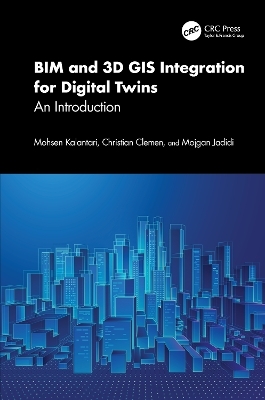
BIM and 3D GIS Integration for Digital Twins
Crc Press Inc (Verlag)
978-0-8153-9175-3 (ISBN)
Building information modelling (BIM) uses a combination of technologies and resources to capture, manage, analyse, and display a digital representation of the physical and functional characteristics of a facility. A Geographic Information System (GIS) offers tools for visualising and analysing built and natural environments and their impacts on infrastructure systems, such as land use, transportation, etc. This book offers a framework for how the geospatial and surveying industry can create and integrate BIM with GIS. Through practical implementation methods, readers will learn to merge GIS data with design and BIM data to enable digital twins.
This book presents the following features:
Integrates BIM and GIS from a geospatial and surveying point of view for the first time;
Addresses the creation of BIM from existing constructed buildings instead of typical pre-construction scenarios;
Explains how to deliver BIM-suitable surveys to surveyors and geospatial practitioners;
Provides surveying and geospatial industry expertise in the collecting, locating, managing, and communicating of BIM;
Introduces new knowledge on the validation and integration of BIM and GIS within the spatial industry.
This is an excellent book for professionals working with 3D data for built-environment digital twins, such as city planners, land surveyors, and geospatial practitioners. It is also an insightful resource for those working and studying in the fields of GIS, surveying, and geospatial engineering, providing the most current tools and resources for dealing with BIM.
Mohsen Kalantari is an Associate Professor of Geospatial Engineering at the School of Civil and Environmental Engineering and a Co-Founder of the Scan-to-BIM technology start-up Faramoon. His research interests are land administration, 3D GIS and BIM. He previously worked for the Department of Infrastructure Engineering at the University of Melbourne. Before his academic career, he worked with the surveying and spatial industry as the Victorian coordinator of a nationwide land and survey information modernisation initiative, ePlan, in Australia. Christian Clemen is a full Professor for “BIM and surveying” at the School of Geospatial Information, University of Applied Sciences Dresden, Germany (HTWD). He previously worked as a trained surveying technician in an engineering office, researcher at the Technical University of Berlin, received his PhD and worked as a software developer for GNSS real-time systems. In addition to teaching, Christian Clemen is actively involved in standardization (DIN/CEN/ISO/buildingSMART). For over two decades, he has been engaged in the 3D-information-modelling of buildings and the semantic integration of the AEC and geospatial domains, always from the perspective of surveying practice. Mojgan Jadidi is an Associate Professor of Civil Engineering at Lassonde School of Engineering, York University, Canada. Her research interests include Development of Digital Twins by integrating Building Information Model (BIM), GIS, and sensors data, Geospatial Visual Analytics, Spatial Quantum Computing for the applications of Smart Environmental/Building/Infrastructure/Cities. She founded Geospatial Visual Analytics (GeoVA) Lab where she passionately drives the research in cutting edge technology development for a safer and resilient built environment. She also connects her technical expertise to classrooms, providing an immersive learning experience using virtual and augmented reality and gamification technologies in engineering education.
1. Why Do Digital Twins Matter? 2. Fundamentals of 3D Modelling. 3. Building Information Modelling. 4. Creating BIM using 3D Laser Scanning. 5. Georeferencing 3D Models. 6. BIM and GIS Integration. 7. Built Environment Digital Twins.
| Erscheinungsdatum | 22.11.2024 |
|---|---|
| Zusatzinfo | 16 Tables, black and white; 14 Line drawings, color; 37 Line drawings, black and white; 8 Halftones, black and white; 14 Illustrations, color; 45 Illustrations, black and white |
| Verlagsort | Bosa Roca |
| Sprache | englisch |
| Maße | 156 x 234 mm |
| Gewicht | 462 g |
| Themenwelt | Naturwissenschaften ► Biologie ► Ökologie / Naturschutz |
| Naturwissenschaften ► Geowissenschaften ► Geografie / Kartografie | |
| Technik ► Bauwesen | |
| Technik ► Bergbau | |
| Technik ► Umwelttechnik / Biotechnologie | |
| ISBN-10 | 0-8153-9175-7 / 0815391757 |
| ISBN-13 | 978-0-8153-9175-3 / 9780815391753 |
| Zustand | Neuware |
| Informationen gemäß Produktsicherheitsverordnung (GPSR) | |
| Haben Sie eine Frage zum Produkt? |
aus dem Bereich


